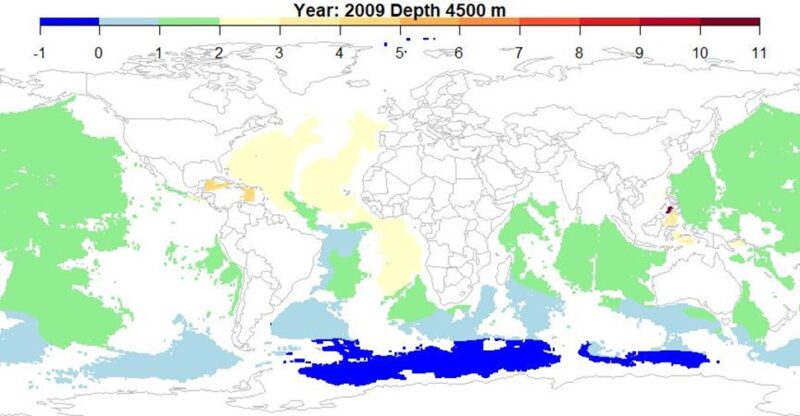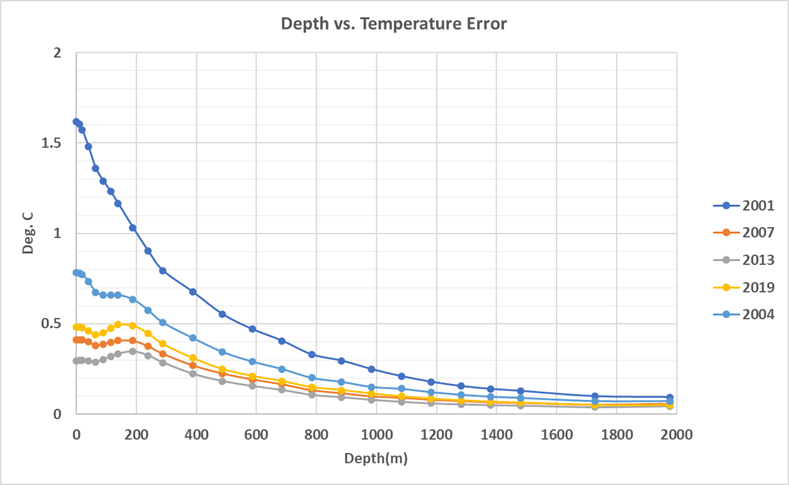A considerable amount of new information on ocean temperature has been gathered since I last wrote about the subject in 2016 here. In my last post on GHCN and the National Temperature Index, it appeared that ocean temperature trends and the thermal energy distribution in oceans dominate climate change. Land-based weather stations are invaluable for weather prediction, but they tell us very little about climate change. The common definition of climate is an overall change in temperature or precipitation over a period longer than 30 years. But even 30 years is a short timeframe, 100 years might be better. On this timescale, ocean temperature trends are more significant.
Oceans cover 71% of Earth and they contain 99.93% of the thermal energy (“heat”) on the surface. Here we define the Earth’s surface as everything between the sea floor to the top of the atmosphere, ~22km. This calculation, and the necessary references, are detailed in this spreadsheet. As an illustration of the huge impact of the oceans, we should consider that Earth’s oceans contain more thermal energy than exists on the surface and in the atmosphere of Venus, where the temperature is 464°C or 867°F. In fact, Earth’s oceans contain four times more thermal energy than the atmosphere of Venus, yet the oceans have an average temperature of less than 5°C. A spreadsheet containing this calculation and the necessary references can be downloaded here.
We still do not have accurate information on the entire ocean, but we do have a lot more than in 2016. CSIRO has a nice 2009 dataset of temperature data to 5,500 meters here (Ridgeway, Dunn, & Wilken, 2002). The University of Hamburg has multi-year data to 6500 meters here, but I was unable to read their NetCDF files with R. I tried both R NetCDF packages (ncdf4 and RNetCDF) and neither could open their files. If anyone knows how to read these files, let me know. In the meantime, the CSIRO NetCDF files opened easily, and we can work with their data, even though it only covers one year. Figure 1 is the average global CSIRO ocean temperature from the surface to 5,500 meters.

Figure 1. CSIRO 2009 global average temperature from the surface to 5,500 meters. Data source: CSIRO.
The temperature drops to a minimum of 1°C at ~4,250 meters and then begins to increase. The distribution of temperature at 4,500 meters is shown in Figure 2.

Figure 2. CSIRO ocean temperature at 4,500 meters. The white areas on the map are shallower than 4,500 meters.
Signs of the thermohaline circulation can be seen in these temperatures. It is still unclear how often the ocean water completely overturns. By overturning, we mean the amount of time required for downwelling surface water to make a completely deep-water circuit and then come back to the surface. This process probably takes at least 1,000 years. It is the major long-term heat exchange process on the surface of the Earth. Thus, when the Earth is receiving more thermal energy from the Sun, or CO2 or whatever is causing warming, it takes a thousand years or longer for it to circulate through the oceans. Figure 3 is a map showing the paths the water takes through the deep ocean.

Figure 3. The major paths deep water takes as it moves from the surface into the deep ocean and then emerges a thousand or more years later. Notice Antarctica is in the center of the map. This is because all the oceans only meet in the Southern Ocean, which surrounds Antarctica. Source: By Avsa – Wikimedia, CC BY-SA 3.0.
As we can see in Figure 3, surface water dives into the deep ocean in the North Atlantic and in the Southern Ocean. It then begins to travel around the world, through all the oceans. It upwells mostly in the in the Indian Ocean, Southern Ocean, and in the Pacific. Because deep water moves out of the Atlantic, but mostly upwells in the other oceans, the Atlantic has a slightly lower sea level than the other oceans. Also see (Reid, 1961). Upwelling deep water is more widespread than downwelling. This NASA web page contains a good discussion and animation of the thermohaline circulation.
Figure 2 shows some mixed temperatures in the Southern Atlantic, next to South American and Southern Africa, this suggests some upwelling might be taking place there. But most upwelling appears to be in the Pacific, Southern, and Indian Oceans.
Discussion and Error
Unfortunately, good data on ocean temperature only goes back to 2004. The data we have suggests that the oceans are warming at a rate of 0.4°C per century. However, the ocean cycle-time is over 1,000 years and the record is only 15 years, so this is very speculative. However, if the oceans are truly only warming at a rate of 0.4°C per century, it seems very unlikely that the speculation about rapid and dangerous warming of the atmosphere is anything to worry about.
The Jamstec (Hosoda, Ohira, & Nakamura, 2008) grid, which we’ve used for the shallower (< 2,000 m) portion of our analysis provides us with an estimate of error. It is an estimate of spatial error, which can also be called gridding error. In other words, do we have enough data to make the map accurately? Figure 4 is a map of this error by year and depth.

Figure 4. Jamstec gridding error in degrees C. Data source: Jamstec.
As we can see in Figure 4, the error in 2001 was quite high until a depth of 1609 meters or so was reached. By 2004, depths below 1,000 meters were OK. As Figure 1 shows, depths shallower than 1,000 meters are highly variable and high errors are expected. These shallower waters interact with surface weather, especially in the so-called “mixed layer.” The mixed layer is a shallow zone where turbulence has caused a near constant temperature from the top to the bottom of the layer. The thickness of the mixed layer varies by season and area, but averages about 60 meters. The mixed layer temperature reflects, in a complex fashion, the surface temperature of the previous few weeks.
In our view, the attempts to deduce the magnitude and rate of atmospheric warming using only sea-surface and atmospheric temperature measurements is foolish and doomed to fail. The true “control knob” of long-term temperature change is the oceans. They regulate the surface temperatures through their enormous heat capacity. The mixed layer alone has over 22 times the heat capacity of the whole atmosphere to 22 km. The regulation of atmospheric temperatures by the oceans also gives us a lot of time to determine if global warming is truly a threat. Currently, we only have about fifteen years of ocean temperature data, but in fifteen more years we will have data over a “climatic” period. If the ocean warming trend in 2035 is still less than one degree per century, we have very little to worry about.
I used R to do the calculations plotted in the figures, but Excel to make the graphs. If you want to check the details of my calculations, you can download my CSIRO R source code here.
None of this is in my new book Politics and Climate Change: A History but buy it anyway.

Andy May, now retired, was a petrophysicist for 42 years. He has worked on oil, gas and CO2 fields in the USA, Argentina, Brazil, Indonesia, Thailand, China, UK North Sea, Canada, Mexico, Venezuela and Russia. He specializes in fractured reservoirs, wireline and core image interpretation and capillary pressure analysis, besides conventional log analysis. He is proficient in Terrastation, Geolog and Powerlog software. His full resume can be found on linkedin or here: AndyMay
